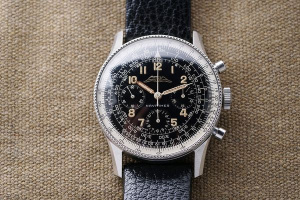Breitling Navitimer 806: Difference between revisions
| Line 1: | Line 1: | ||
==Breitling Navitimer | ==Breitling Navitimer== | ||
==Brief History== | |||
The Breitling Navitimer is an evolution of the 1942 Breitling Chronomat, with its typical slide rule bezel. Breitling decided to improve this highly practical bezel and in 1952, the ‘Navi’ was born. This slide rule bezel was used to calculate complicated operations without any other tool. The 1942 Chronomat came with an out-sourced movement, the Venus 176. It was used by the United States Air Force. | The Breitling Navitimer is an evolution of the 1942 Breitling Chronomat, with its typical slide rule bezel. Breitling decided to improve this highly practical bezel and in 1952, the ‘Navi’ was born. This slide rule bezel was used to calculate complicated operations without any other tool. The 1942 Chronomat came with an out-sourced movement, the Venus 176. It was used by the United States Air Force. | ||
| Line 12: | Line 12: | ||
The man behind the development of this new calibre was Gérald Dubois, who was working for Dépraz & Cie (now famous with the name Dubois Dépraz). Using a base calibre from Buren (a thin automatic movement with a micro-rotor), Dubois worked together with Jack Heuer and Willy Breitling to develop this brand new idea of an automatic chronograph. And that cooperation led to the creation of a modular chronograph mechanism, added on the top of the Buren calibre (for that reason, the integrated micro-rotor is invisible). The legendary [[Calibre 11]] was born. One very unique feature of this movement is its left-positioned crown (the pushers are, as usual, located on the right side of the case). The introduction of this movement changed massively the face of the Navitimer that moved from a tri-compax layout to a bi-compax with date at 6 o’clock configuration. See also the [[Heuer Monaco]] for use of this movement. | The man behind the development of this new calibre was Gérald Dubois, who was working for Dépraz & Cie (now famous with the name Dubois Dépraz). Using a base calibre from Buren (a thin automatic movement with a micro-rotor), Dubois worked together with Jack Heuer and Willy Breitling to develop this brand new idea of an automatic chronograph. And that cooperation led to the creation of a modular chronograph mechanism, added on the top of the Buren calibre (for that reason, the integrated micro-rotor is invisible). The legendary [[Calibre 11]] was born. One very unique feature of this movement is its left-positioned crown (the pushers are, as usual, located on the right side of the case). The introduction of this movement changed massively the face of the Navitimer that moved from a tri-compax layout to a bi-compax with date at 6 o’clock configuration. See also the [[Heuer Monaco]] for use of this movement. | ||
===Pre806 AOPA model=== | |||
[[File:Breitling 806 AOPA.jpg|thumb]] | |||
==Links== | ==Links== | ||
Revision as of 18:14, 24 May 2020
Brief History
The Breitling Navitimer is an evolution of the 1942 Breitling Chronomat, with its typical slide rule bezel. Breitling decided to improve this highly practical bezel and in 1952, the ‘Navi’ was born. This slide rule bezel was used to calculate complicated operations without any other tool. The 1942 Chronomat came with an out-sourced movement, the Venus 176. It was used by the United States Air Force.
1952: the very first Navitimer wore the “Aircraft Owners and Pilots Association” (AOPA) emblem on its dial (the typical double-wing logo) and by 1960, a real cooperation with the AOPA began. The “Navitimer” name is the contraction of “navigation” and “timer”. The first edition to be sold was the reference 806, powered by a manual chronograph movement with column wheel mechanism, the Venus 178.
1954: the 806 was equipped with a Valjoux 72 (the same movement as the vintage Rolex Daytona) and thus, are among the most collectible.
Willy Breitling, helped by the Swiss advertiser Georges Caspari, developed a campaign that targeted groups of pilots and that created a huge demand for navigation chronographs. Furthermore, Breitling continued to be the official supplier of board instruments for all the major aircraft companies – as for example the 1957 Boeing 707, equipped with Breitling dashboard instruments.
At the end of the 1960s, Breitling chose to change the Venus 178 with a Valjoux 7740, a manually wound movement, cam-operated with a date feature. An automatic chronograph movement would follow in 1969.
The man behind the development of this new calibre was Gérald Dubois, who was working for Dépraz & Cie (now famous with the name Dubois Dépraz). Using a base calibre from Buren (a thin automatic movement with a micro-rotor), Dubois worked together with Jack Heuer and Willy Breitling to develop this brand new idea of an automatic chronograph. And that cooperation led to the creation of a modular chronograph mechanism, added on the top of the Buren calibre (for that reason, the integrated micro-rotor is invisible). The legendary Calibre 11 was born. One very unique feature of this movement is its left-positioned crown (the pushers are, as usual, located on the right side of the case). The introduction of this movement changed massively the face of the Navitimer that moved from a tri-compax layout to a bi-compax with date at 6 o’clock configuration. See also the Heuer Monaco for use of this movement.
Pre806 AOPA model

